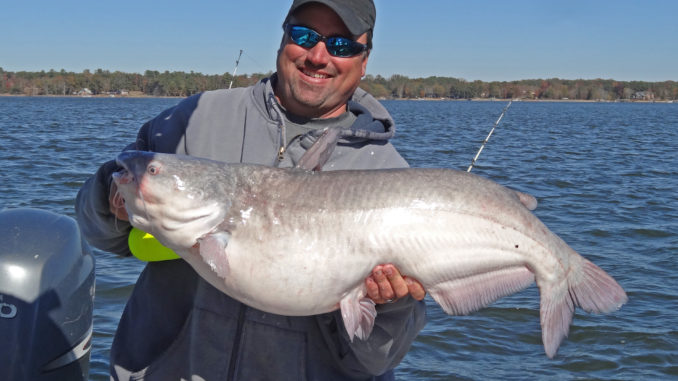
Channel cats and blues making up most of anglers’ catches
Catfishing on Lake Murray is productive and popular year-round, but November and December are the top two months, according to guide Chris Simpson.
“It’s definitely my favorite time of the year, especially for consistently catching big catfish,” Simpson said. “There is a real strong channel catfish bite but now we’ve started catching big blue catfish as well, along with some hefty flatheads and a few big white catfish.
“We’ll have a mixed bag of catfish most days, and most of the blues will be pushing the 30-pound class. Also we’re catching a lot of channel catfish in the 10-pound-plus class. I’d say the channel catfishing at Lake Murray is the best in the state.”
Simpson (864-992-2352) will drift-fish at this time of year.
“I use an 8/0 Gamakatsu circle hook with Berkeley Big Game 25-pound test for my main line and a 50-pound monofilament leader with a 2- to 3-inch float to keep the bait off the bottom,” he said. “I’ll use different weights depending on the depths I fish, but usually one to two ounces with a slinky drift rig will work just fine. My favorite bait right now is cut herring.”
Simpson has been catching his fish between 25 and 60 feet deep; the target area will change depending on forage, weather and water conditions.
“It all really boils down to forage,” Simpson said. “I ensure I see lots of forage on my graph in addition to what I believe are catfish marks near the lake bottom when I set up. The forage will move from one area to another, and cloud cover, wind and water temperature will all play a role. I may find forage and catfish in a creek one day, near a creek mouth another day and in the main river the next trip. Or it can change, and I’ll find them in all of the above places on a single day.
“The key is to mark forage and finding active, biting fish together, and then put together a pattern of depth and speed. The best speed will vary from .4- to 7 miles per hour. I vary that until I get that right. Some days it makes little difference as long as it’s in that range, but on some days the exact speed can be a real key to success. Being near the edge of the creek or river or actually in the channel is important on most days.
“I’ll change lcoations until I hit the right pattern, then work that specific pattern hard,” he said. “On a typical day, we may catch 15 to 20 catfish … you can expect most all of them to be very good size. The big blue catfish do seem to have a tendency to be near the main-river channel. I’m not catching a lot of blues, but those we catch are usually big.”
Simpson is doing most of his fishing on the upper end of the lake.
“The forage moves up the lake as the water temperature drops, so the catfish are there,” he said. “The channel and blue catfish are predominantly what I catch, but at this time of year, the occasional flathead up to the 30-pound class is caught. Also, some very large white catfish are caught, and we recently caught one that was less than a pound off the state record.”





Be the first to comment